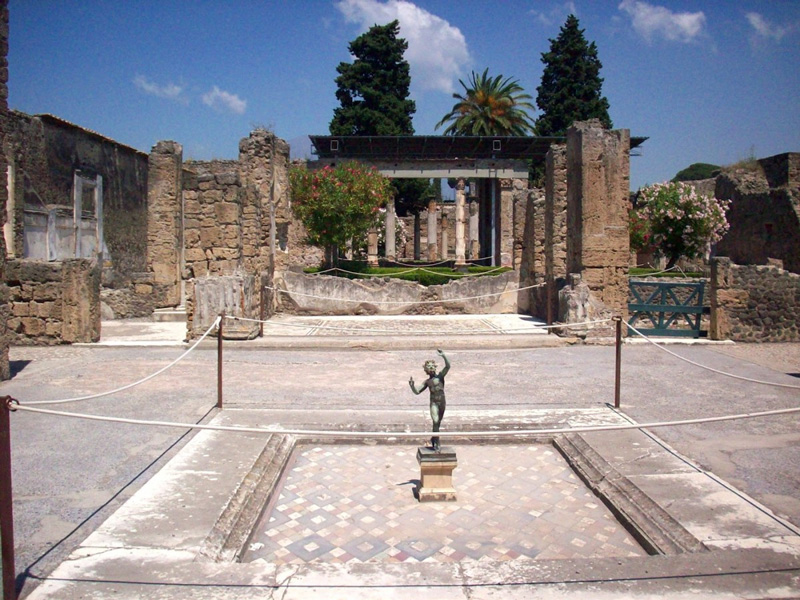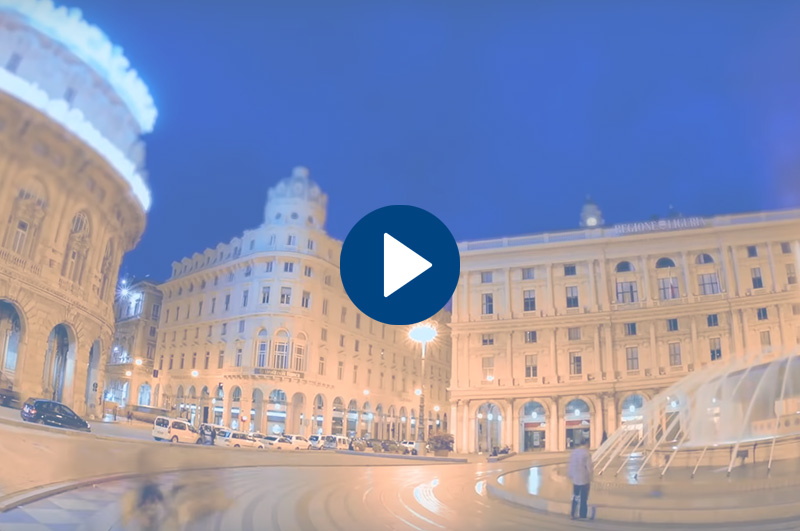ITALY IN 2 WEEKS - PRIVATE LUXURY TOUR
Milan, Venice, Florence, Rome & the Amalfi Coast
HIGHLIGHTS
- Milan, the vibrant 2,000-years-old capital of Northern Italy
- Venice, when merchants ruled the Mediterranean
- Florence, an open-air museum
- Siena and San Gimignano, power in the Middle Ages
- Rome, walking in the shade od history
- The Vatican, Popes and power
- Tivoli, an invitation from the Emperor
- The Amalfi Coast, where divas are at home
- Pompei, the Roman city fixed in lava
DATES & PRICES
-
April 1st to May 31st – October 1st to 31st (Shoulder Season): from € 16,465.00 / pax (2-pax group) – from € 12,980.00 / pax (4-pax group)
-
June 1st to September 30th (High Season): from € 18,475.00 / pax (2-pax group) – from € 14,980.00 / pax (4-pax group)
Larger Group, Single Occupancy, Room with a view: price upon request
GROUP SIZE: 2 to 15 travellers
WHAT'S INCLUDED:
Accommodations in Double Room with Continental Breakfast (*):
- Days 1 & 2: 5* Radisson Collection Hotel, Palazzo Touring Club Milan - Corso Italia 10, Milano - Radisson Collection Hotel, Palazzo Touring Club Milan (radissonhotels.com) - Ph. +39 02 1241 28300
- Days 3 & 4: 5* Hotel Metropole - Riva degli Schiavoni 4149, Venezia - http://www.hotelmetropole.com/en/ - Ph. +39 041 5205044
- Days 5 & 6: 5* Golden Tower Hotel & SPA - Piazza Strozzi 11/r, Firenze http://www.goldentowerhotel.it/en/index.html - Ph. +39 055 287860
- Days 7 & 8: 5* Precise Tale Poggio Alla Sala – Via Poggio Alla Sala 10, Montepulciano (SI)- https://www.precisehotels.com/en/poggio-alla-sala - +39 0578820050
- Days 9 & 10: 5* Pantheon Iconic Hotel - Via di Santa Chiara 4/A, Roma - https://www.thepantheonhotel.com/en/hotel/ – Ph. +39 06 87807070
- Days 11 to 13: 5* Anantara Convento Amalfi Hotel- Via Annunziatella 46, Amalfi (SA) - https://www.anantara.com/en/convento-di-amalfi – Ph. +39 089 8736711
- Day 14: 5* Grand Hotel Vesuvio - Via Partenope 45, Napoli - https://www.vesuvio.it/en/ - Ph +39 081 7640044
(*) The Hotel list is indicative and subject to room availability – During High Season, one or more rooms may be unavailable; if so, we will propose a suitable alternative - To check the Hotel position, please click on its name
Transfers (**):
- Day 1: Transfer from Milan Airport to your accommodation in Milan
- Day 3: Transfer to Venice Pier + Transfer by private water cab to your accommodation in Venice
- Day 5: Transfer by private water cab to Venice Pier + Transfer to your accommodation in Florence - Stopover in Modena and Maranello
- Day 6: Transfer from your accommodation in Florence to the restaurant and back
- Day 7: Transfer to your accommodation in Val d’Orcia area
- Day 9: Transfer to your accommodation in Rome – Stopover in Tivoli
- Day 11: Transfer to Rome Railway Station + Transfer by high-speed train Executive 1st Class to Naples Railway Station +Transfer to your accommodation on the Amalfi Coast
- Day 13: Round trip from your accommodation to Amalfi/Positano Harbour
- Day 14: Transfer to your accommodation in Naples - Stopover in Pompei - Transfer from your accommodation to the restaurant and back
- Day 15: Transfer to Naples Airport
(**) All transfers by private Luxury Water Cab / Sedan (2 pax) / Minivan (3 to 6 pax) / Minibus (7 to 14 pax)
Private Guided Visits / Tours / Activities (***):
- Day 1: Meet and Greet at Venice Airport
- Day 2: 3-hour private walking tour of Milan city centre with an Authorised Tourist Guide
- Day3: One-hour Gondola ride
- Day 4: 3-hour private walking tour of Venice city centre with an Authorised Tourist Guide – Private visit of a “Squero” Gondola Boatyard
- Day 5: Visit of a Traditional Balsamic Vinegar Producer in Modena area - Private guided visit of Museo Ferrari in Maranello
- Day 6: 3-hour private walking tour of Florence city centre with an Authorised Art Historian Guide
- Day 7: Full-day excursion to Siena and San Gimignano - 2-hour private walking tour of Siena city centre with an Authorised Tourist Guide
- Day 8: Full-day excursion to Val d’Orcia area - 3-hour private walking tour of Montepulciano city centre with a Sommelier Guide, with tastings of Vino Nobile, Pecorino cheese and truffle - Visit of a Supertuscan Brunello di Montalcino wine cellar with tasting
- Day 9: Full-day tour in Tivoli with an Authorised Art Historian Guide
- Day 10: 3-hour private walking tour of the Colosseum and Imperial Fora Archeological Area with an Authorised Archeological Guide – Roman Cooking Class at a Home Restaurant
- Day 11: 3-hour private walking tour of the Vatican Museums and the Sistine Chapel with an Authorised Art Historian Guide
- Day 12: Full-day excursion of the Amalfi Coast: Amalfi, Positano and Ravello
- Day 13: Full-day private boat tour to Capri Island with lunch on board
- Day 14: 2-hour private private walking tour of Pompeii Archeological Area with an Authorised Archeological Guide
(***) All tours by private luxury Sedan (2 pax) / Minivan (3 to 6 pax) / Minibus (7 to 15 pax)
Admission Tickets to:
- Duomo Cathedral and Rooftop in Milan
- Palazzo Ducale in Venice
- Saint Mark’s Basilica in Venice
- Museo Ferrari in Maranello
- Galleria dell’Accademia in Florence
- Hadrian’s Adriana & Villa d’Este in Tivoli
- Colosseum and Imperial Fora Archeological Area, with access to the Arena and the Underground (if available) in Rome
- Vatican Museums and Sistine Chapel in Rome
- Pompei Archeological Area
Meals
- Dinner at a selected restaurant with VITOR Founder an CEO in Milan
- Dinner at a selected restaurant in Florence
- Farewell dinner at a Michelin-starred Restaurant in Naples
Other
- Meet & Greet at Milan Airport
Full emergency assistance 24 hours/day by our Back Office
List of recommended restaurants and deli shops along the itinerary - Restaurant bookings
All taxes- Other options upon request
Day 1 - MILAN
Benvenuti in Italia, welcome to Milan.
Milan is, first of all, the Fashion Capital of Italy! The showrooms of all Italian manufacturers are located in the city, and here buyers from worldwide distribution find the one and only “Italian Style”! But Milan is not only fashion, it is also and above all art, beauty and culture! Piazza del Duomo is the geographical and historical centre of the city. Palaces surround it with arcades; in the middle, you can see the Duomo, one of Europe’s biggest Gothic cathedrals, whose construction started in the 14th and ended in the 20th century. And on the Gran Guglia, the cathedral’s highest spire, the Madonnina, a symbol of Milan, stands. On the left of the square, the 19th-century Galleria Vittorio Emanuele II links the grand Piazza del Duomo with Piazza della Scala, featuring mosaics and a wrought iron and glass roof.
Then stroll down the streets of “Quadrilatero D’Oro”, the heart of the fashion industry, admiring the shop windows of Prada, Armani, Versace, Ferragamo, Dolce & Gabbana and Valentino. The multi-concept store by Giorgio Armani, Spazio Armani, in the elegant Via Manzoni, extends for 6,000 square meters and offers fashion showrooms, furniture, flowers and hi-tech Sony equipment. After shopping, enjoy an aperitif or a coffee at the Emporio Armani Cafè upstairs or book a table at the Japanese restaurant Nobu. Or taste a gorgeous Cappuccino at Pasticceria Cova, as locals often do in via Montenapoleone, “Montenapo” for the Milanese!
At dinner, what about a tasty yellow “Risotto alla Milanese”? According to an ancient tradition, the Duomo is where Risotto alla Milanese was “born”, invented by a boy who worked for the stained glass artist Valerio di Fiandra, nicknamed “Zafferano” for its habit of adding spices to his colours. One day, he also put some saffron in the rice, and the result was a great success!

Day 2 – VERONA
In a stretch of land designed in accord with the bends and twists of the River Adige, we find Verona, a visually stunning city of excellence. It is a city of many faces whose history can also summarize Italy's history – think of the works left by the Romans, the Medieval streets and the “palazzi” of the Renaissance.
The city’s commercial hub is Piazza delle Erbe, where the original Roman Forum was. This piazza represents the synthesis of several different historical moments: the 13th-century buildings – among which Casa dei Mercanti (House of Merchants) stands out - the painted facades of the Mazzanti Houses and the Madonna Verona Fountain, with its central statue from the Roman Epoch. Also dating back to Roman times is the most symbolic monument of Verona, the Arena (1st century B.C.). Originally constructed to host gladiator combats, it saw a long period of abandonment before it returned to the limelight with a new form of entertainment in 1913: after having hosted the premiere of Aida in that year, it has been known around the world for the sounds of opera that emanate from its stage.
Then, Romanesque Verona lies in its imposing Duomo, as well as in the Cathedral of St. Zeno, and in Castelvecchio, which looks out from the banks of the Adige; it symbolizes the Medieval power of the Scaliger family, to whom the realization of the crenellated Scaliger Bridge is attributed.
The palazzi of Verona narrate its long history of wealth and power. In Piazza dei Signori - which sits under the dominating Lamberti Towers - the portico of the Loggia del Consiglio catches the eye; in the 16th century, political life took place here, while the Palazzo di Cansignorio and Palazzo del Comune (or “della Ragione”) were the seats of military, judicial and administrative power. Nearby lie the Scaliger Arches, in the same-named piazza, and some of the most suggestive views of the city, including glimpses of the monumental tombs of the Lords of Verona.
Finally, the Verona of Shakespeare and the “star-crossed lovers” is a worldwide legend and lives indefinitely through the places made famous in Romeo and Juliet. Yet the original literary work was created by Luigi da Porto, a writer from Vicenza, in the 1500s; it eventually circulated in Europe, reaching England. It was the Bard who rendered it the immortal story it is today, allowing Verona to rest as one of the most admired and visited places in the world.
And remember: Verona is a very elegant city, famous for its classy shops!
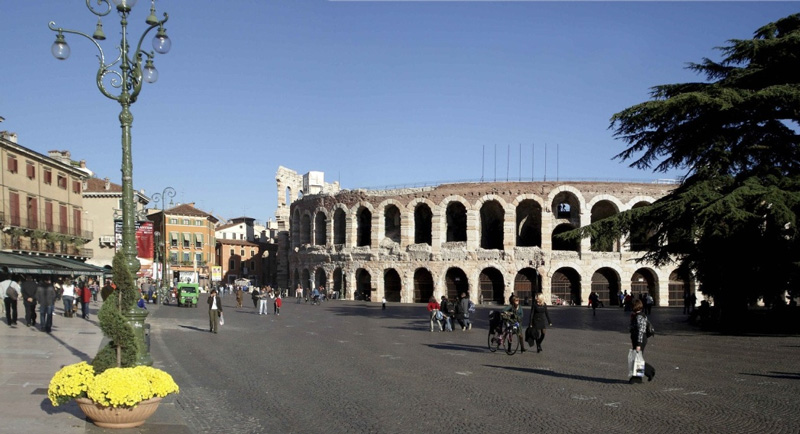
Day 3 – VENICE
Here you are in the “unique” Venice, the “city on the lagoon”, you will be astonished by its beauty and charm! You will start your visit with Piazza San Marco (St. Mark’s Square) and the interior of the Basilica, a 900 years old marvel of architecture! The church is unique in Italy for its golden Byzantine and Medieval mosaics, its intricate stone and marble traceries and exuberant Middle Eastern domes. Near St. Mark’s Basilica is Palazzo Ducale, the most impressive secular building in Venice and once the official residence of the supreme authority of Venice, the “Doge”. A masterpiece of Gothic architecture, the Doge’s Palace is an impressive structure composed of layers of building elements and ornamentation, from its 14th and 15th-century original foundations to the significant Renaissance and opulent Mannerist adjunctions.
At lunch, you may relax by tasting wine and savouring delicious ”cicheti”, the Venetian version of finger food. There is tremendous variety, and options include anything from simple cheese or salami to almost any kind of seafood, fried and grilled vegetables, sweet and sour sardines, creamy codfish and much, much more!
Then you may visit Santa Maria Gloriosa dei Frari (Saint Mary’s of Friars), striking for its huge size and for the quality of its works of art, including masterpieces by Titian, Giovanni Bellini and Donatello, and several grandiose tombs. Also, explore the streets and savour everyday life in an intricate maze of ancient narrow alleyways, lively squares with magnificent buildings and meandering canals, and finally walk on the Rialto Bridge, the busy "heart" of Venice. And last but not least, enjoy a Gondola ride on the city’s canals: a jump back in time, when Venetians moved only on the water.
Knowing what should be bought in Venice is not easy, as it is one of the most beautiful Italian cities. Rich in traditions, Venice presents a wide selection of souvenirs to take home as a souvenir of your trip. What you cannot miss among your purchases are the typical Venetian masks. The cost of the original ones is quite high, but it is really worth it! Another thing you should not get away from Venice without is a Murano glass object. Each product is worked and painted by hand, but be sure you buy an original product from Murano, guaranteed by a label or a signature (and also by the seller), and not a Chinese copy!
Upon request, you may also visit some ateliers in the city and see artisan masters at work, making rows for gondolas or transforming iron and gold into precious objects according to techniques passed down from father to son.
If you do not have enough of the shopping, you can take a leap to the markets. A must-see is Mercato di Rialto, the Rialto fish Market in Venice! The market is buzzing with life. Scour the stalls of the Pescaria for glistening mountains of moscardini (baby octopus), moeche (soft-shell crabs), and inky seppie (squid) and take as many pictures as you want! Those who love sweets can go to a bakery and buy the famous Carnival “fritole”, “baicoli” or “spuncioti de caramel”.
At dinner, you will be delighted by the flavours of the regional cuisine of Veneto, boasting delicious recipes such as “Sarde in saor”, Risotto with seafood, the typical “Baccala' mantecato”, to finish with a fantastic "Bussolà” (for an overview of the regional cuisine of Veneto see the article in our BLOG).

Day 4 – MODENA
Modena is renowned worldwide for the famous people - Enzo Ferrari and Luciano Pavarotti above all - who were born and lived here, and for some of its gastronomical products. The city is the capital of the so-called “Motor Valley”: actually, the factories of the famous Italian sports car makers Ferrari, De Tomaso, Lamborghini and Maserati are located here.
The city of Modena hosts little jewels of art, such as the Romanesque Cathedral, wholly constructed with white marble and located in the heart of Modena, in Piazza Grande. The Piazza with the Cathedral and the Ghirlandina Tower is one of the 48 Italian sites on the UNESCO World Heritage List. The Ghirlandina, the bell tower rising majestically over the rooftops, derives from its marble balustrades around the steeple, suggesting the lightness of garlands.
In Maranello, you may visit Museo Ferrari, not just a collection of the past but an extraordinary experience of the world of Ferrari and sports car racing! How exciting to see the most beautiful cars in the world, exceptional artworks made by modern mechanic artisan masters.
Afterwards, you will move to the estate of a Balsamic Vinegar of Modena Producer, to delight in the unique, enticing taste of traditional balsamic vinegar. Balsamic Vinegar of Modena is obtained from partially fermented, cooked and concentrated grape must. The grapes come exclusively from the area's vines, and the most critical processing phase is refinement inside containers of fine wood, such as oak, chestnut, oak, mulberry and juniper. Want to know more about this unique delicacy? Read the article in our BLOG.
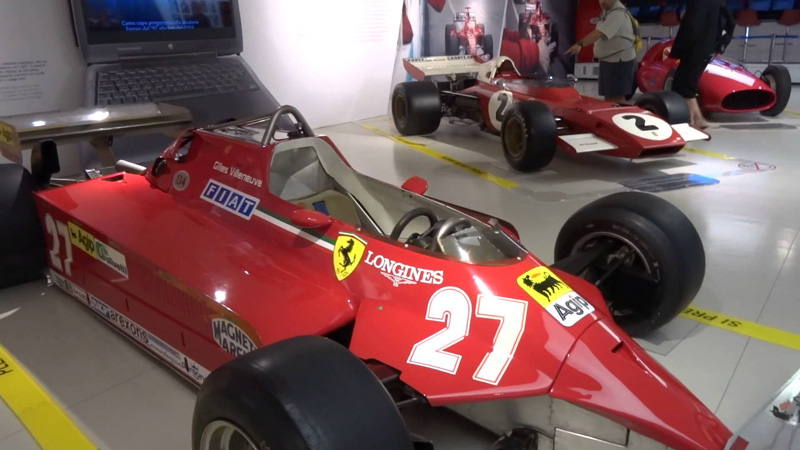
Day 5 – FLORENCE
Welcome to Florence, the land of Giotto and Dante!
Despite its international fame and greatness, Florence is also a small city whose history has been interwoven with that of its passionate citizens for more than one thousand years
In Piazza Duomo, you will be astonished by the Duomo with the incredible Brunelleschi’s dome, a masterpiece of art and architecture whose building techniques are still covered by a veil of mystery. Beside it, Giotto’s Belltower and the Baptistery, one of the oldest buildings in the city, with its famous bronze doors made by no and Ghiberti in the 14th and 15th centuries. In Piazza della Signoria, you will walk in the middle of bronze and marble masterpieces by Giambologna and Cellini inside the marvellous Loggia dei Lanzi, and will admire the imposing Palazzo Vecchio, one of the symbols of Florence and still the seat of government of the city. You may also spare some time to relax, visiting a typical market for shopping, strolling through the city's pedestrian streets, and crossing the oldest bridge in Florence, “Ponte Vecchio” (Old Bridge), rich in jewellery shops.
Your itinerary may include Galleria dell’Accademia, hosting Michelangelo's David, the most famous sculpture in the world. The David was uncovered and shown to the Florentines on September 8, 1504, and with its height of 4 meters, the impeccable physical features and the political significance that the iconography of David had taken over the previous century left the Florentines of the time speechless and has done the same ever since with visitors from all over the world.
Florence is also the main Italian centre for the production of high-quality leather goods. Florentine artisans are so famous that many fashion brands have opened factories in the city or close to it due to their high skill and the continuous inspiration designers take from the town’s masterpieces. The area around Piazza Santa Croce, in particular, hosts numerous leather shops and workshops.
Thanks to the tradition of Tuscan tanneries, there is no better place to find shoes for all tastes than Florence: from the creations, designed and produced by hand by skilled craftsmen, to the extensive collections available in stores, renewed every season. Above all, Ferragamo (also worth seeing the museum), Gucci and Prada for refinement and elegance. If you prefer a simpler style, many shops specialise in handmade shoes and sandals across the river Arno.
At lunch, you may enjoy “Panino con Lampredotto” in a typical Florentine market. At dinner, taste the simple yet unforgettable recipes of the Tuscan tradition, such as "Crostini", "Panzanella", and "Peposo". And remember, Florence is the home of "Fiorentina" steak! In case you are a vegetarian, don’t worry: Tuscan cuisine offers tasty alternatives like “Pappa al Pomodoro” or “Ribollita” (read our BLOG to know more about Tuscan Cuisine).

Day 6 – SIENA & SAN GIMIGNANO
In Siena, the city of the Palio, you will walk on the famous Piazza del Campo, the concave square where horses run twice a year in a dangerous race that symbolizes the city’s freedom. On the days of the Palio, the whole town goes crazy; read about it in our BLOG. Indeed, you will not forget the colour of frontages and roofs, the renowned colour “Sienna”, a pigment first produced during the Renaissance, that makes the city lovely and warm. And don’t forget to taste the Senese sweets: “cantucci” (biscuits with toasted almonds), “ricciarelli” (soft biscuits with icing sugar), “panforte”(cake with fruit nuts and spices) and “cavallucci” (biscuits with honey, walnut, candied fruits and spices. Travellers who love dessert will be delighted!
In the afternoon, you will stroll with your head upwards along the streets of one of the most beautiful cities in Tuscany, San Gimignano, also known as the "Medieval Manhattan", thanks to its old and impressive 14 towers that dominate the town skyline. Originally the towers were 72, built by patrician families probably to demonstrate their wealth and power. Seven of San Gimignano's towers are around Piazza del Duomo; the tallest one is Torre Grossa, 54 meters high, dating back to 1298.
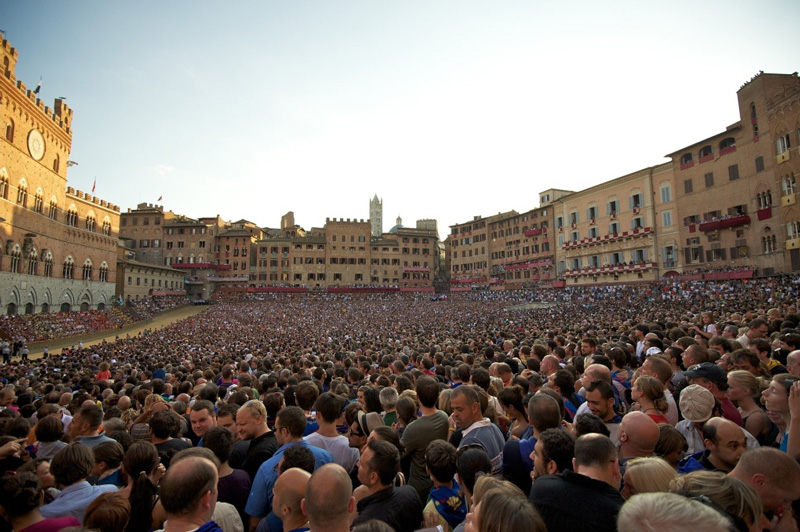
Day 7 - VAL D'ORCIA
Val d’Orcia is one of the most fascinating places in Italy, included by UNESCO in the list of World Heritage Sites. Its landscape is a part of the agricultural hinterland of Siena, redrawn and developed when it was integrated into the city-state's territory in the 14th and 15th centuries to reflect an idealized model of good governance and create an aesthetically pleasing picture. The landscape’s distinctive aesthetics, flat chalk plains with almost conical hills and fortified settlements on top, inspired many artists. Their images have come to exemplify the beauty of well-managed Renaissance agricultural landscapes.
Your first stop will be in Pienza, “Pio’s town”: here, Pope Pius II decided to build the perfect palazzo for his papal court according to the project of an “Ideal City" drawn up by artists such as Piero della Francesca. From the loggia of the Palace, you will enjoy a breath-taking panorama of the valley. Pienza is also the area of the typical “Pecorino di fossa” cheese, an absolute delight to the palate!
In Montepulciano, our friend Francesca will lead you to discover this beautiful town full of stories, legends and thousand flavours, introducing you to the excellent products of this unique land: olive oil, pecorino cheese and Vino Nobile di Montepulciano.
Then, you will get to Montalcino, one of the prettiest hill towns in Tuscany. Around the village, rows of olive trees, precious grapevines and yellow fields create an enchanting landscape. Here you may visit a Brunello winery to taste the most famous SupertuscanSupertuscan wine, probably the best Italian red!
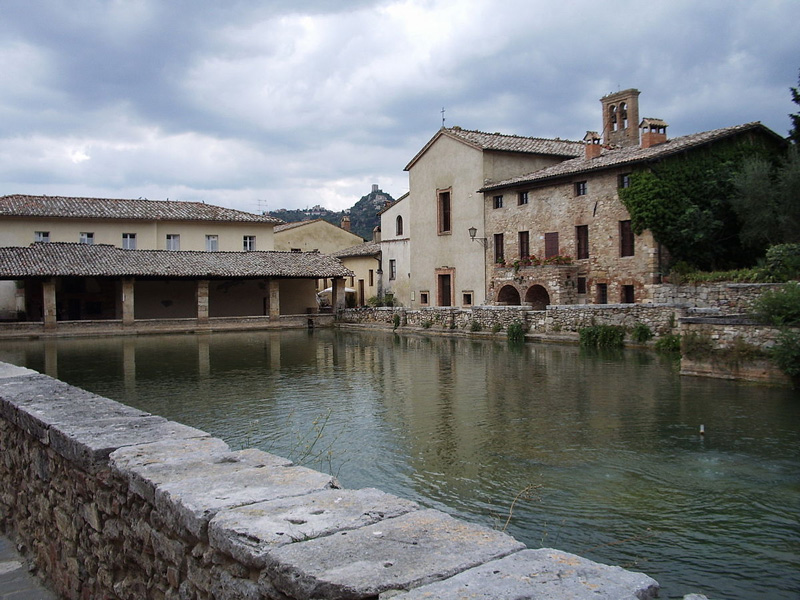
Day 8 – ORVIETO
Orvieto in Umbria is perhaps the most beautiful hill town in Italy, perched up on a volcanic rock, its history dating back to the Etruscans.
Although just an hour from Rome, the architecture is different, with many of the buildings constructed out of “tufo”, a volcanic rock. Orvieto’s main attraction is its 14th-century Cathedral – a masterpiece of Gothic architecture with a glistening façade of stained glass, mosaics and sculptures. Another attraction is St. Patrick’s Well, a 62-meter-deep (203 feet) feat of engineering characterized by two spiral staircases that wind around the well (yet never meet), with 248 steps down to the water. A pleasant guided tour along a straightforward route makes it possible to know Orvieto’s underground world, created by its ancient inhabitants over about 2,500 years of uninterrupted digging. A tour at the discovery of a millenary, surprising and unexpected “Underground City”, you will surely enjoy it!
At lunch, don’t miss “salumi di cinghiale o cervo” (boar or deer sausage) and pecorino cheese and taste the region's prized white truffle oil together with the delicious white wine of the area, Orvieto Classico!
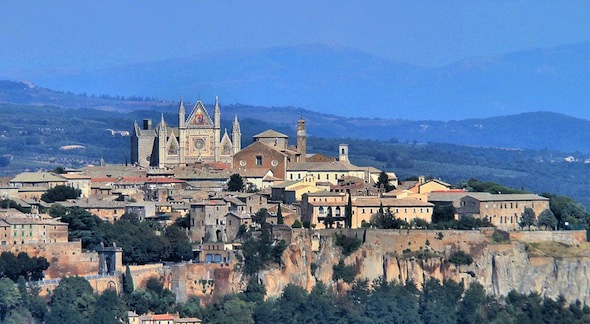
Day 9 – ROME
Here you are in Rome, where ancient history, excellent art and religious icons mix uniquely! Start from the 2,000-year-old Colosseum, the most famous amphitheatre in the world, and the Imperial Fora, the administrative and monumental centre of the Roman Empire. On the Palatine Hill, the majestic ruins of the Palaces of Augusto, Tiberius and Domiziano still dominate theCircus Maximus valley, 50-meter-high structures giving a unique view of the city.
Close to the Colosseum, inside the Church of San Pietro in Vincoli, you may see the famous Michelangelo sculpture of “Moses”. Supposedly, Michelangelo, admiring his Moses, enraptured by the so realistic shapes of the imposing statue, was struck by a violent outburst of anger and exclaimed the famous phrase “Perchè non parli?" (Why don't you speak!?)
From Piazza Venezia, you will head inside “Baroque” Rome, starting with the Pantheon, dedicated to worshipping every god (Pan-every Theon-divinity), now the memorial chapel of great Italian people of the past. After that, don’t miss the Church of St. Louis of the French, famous for the cycle of paintings of the great Caravaggio at the end of the 16th century. Then Piazza Navona, the splendid oval area corresponding to the underground Domitianus’ Stadium, with the gorgeous Fountain of the Four Rivers by Lorenzo Bernini in the centre of the Piazza. And finally, Fontana di Trevi, the city’s biggest and most famous fountain, a Rome icon renowned worldwide: here, statues of travertine marble stand over the cliff and the broad basin in an epic representation of the Kingdom of the Oceans.
At the end of the day, sit down at a local "trattoria" or "fiaschetteria", the typical home-style restaurant, to taste authentic Roman cuisine in a popular and cheerful atmosphere (for an overview of Roman cuisine, see our BLOG).
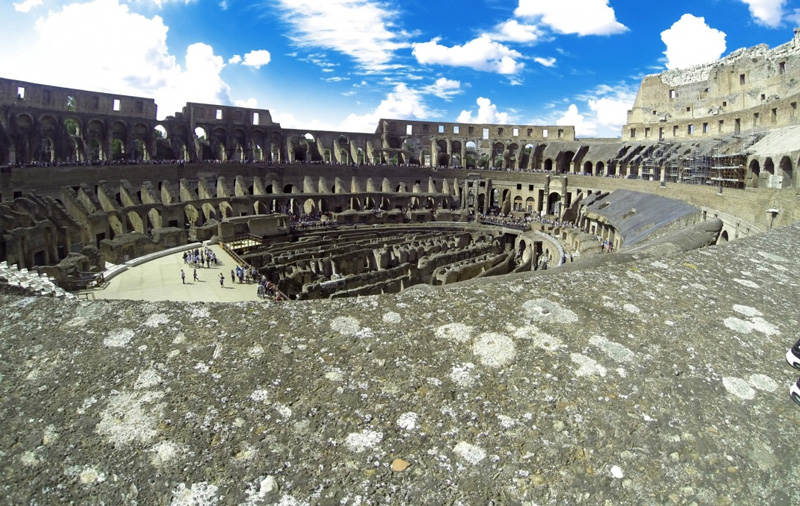
Day 10 - TIVOLI
Discover one of Italy's hidden gems! Here is Tivoli, a small town about 30 Km east of Rome, boasting 2 of the most spectacular sites in Italy, Emperor Hadrian's Villa and Villa d'Este.
Emperor Hadrian built his villa to escape the crowd and turmoil of the capital. Much of the enormous, luxurious ancient villa remains intact today. You will be surprised by the innovative application of Renaissance plumbing in the fountains and waterworks, perfectly integrated with the landscape.
The other masterpiece in the area is Villa d’Este, the fantastic Villa commissioned by Cardinal Ippolito of the Este family around 1560. Among the masterpieces of the Italian Renaissance that most inspired landscape architects and painters, it is an ideal reinterpretation - in a sumptuous way - of the hanging Eden of Babylon. The prestigious residence is surrounded by terraces, stairways and avenues set on each other, decorated with water games so audacious as to reveal considerable engineering skills. The monument was elected the most beautiful park in Europe and UNESCO Heritage with the motivation: "one of the first gardens of wonders, which from the beginning had a decisive influence on the development of European landscape painting ».
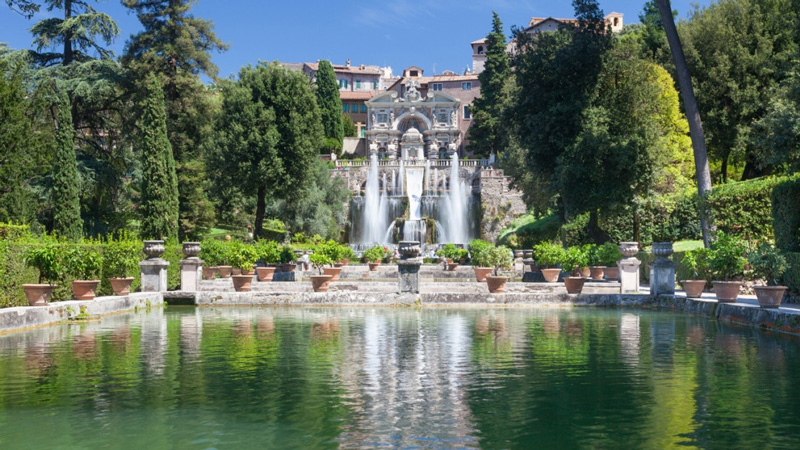
Day 11 – VATICAN CITY
On the other side of River Tevere, Vatican Hill is the home of the tiny state of Vatican City. The immense St. Peter’s Basilica dominates the extraordinary Piazza framed by the magnificent four-column-deep colonnades designed by Gian Lorenzo Bernini. The Basilica is an extraordinary casket for some of the world's most beautiful works of art, such as Michelangelo’s “La Pietà” and Bernini’s “Baldacchino”, along with works of the most important artists of the Renaissance, from Raphael to Canova.
Inside the Vatican Museums, you will be astonished by the exquisite and unique Sistine Chapel, the “Sancta Sanctorum” (“Holy among the Holiest” in Latin) of the Roman Catholic Church, where cardinals gather to elect the new Pope! The Sistine Chapel takes its name from Pope Sixtus IV della Rovere (pontiff from 1471 to 1484), who had the old Cappella Magna restored between 1477 and 1480. The decoration of the walls was executed by a team of painters, Pietro Perugino, Sandro Botticelli, Domenico Ghirlandaio and Cosimo Rosselli, assisted by their respective shops.
Julius II della Rovere (pontiff from 1503 to 1513), the nephew of Sixtus IV, decided to partly alter the decoration, entrusting the work in 1508 to Michelangelo Buonarroti, who painted the Ceiling and, on the upper part of the walls, the lunettes. The nine central panels show the Stories of Genesis, from the Creation to the Fall of Man, to the Flood and the subsequent rebirth of humanity with the family of Noah. Again, towards the end of 1533, Clement VII de' Medici (pontiff from 1523 to 1534) asked Michelangelo to paint the Last Judgement on the altar wall. How could he refuse? And, in fact, he did not, but painted his vision of the Judgement, with a powerful and furious Jesus Christ.
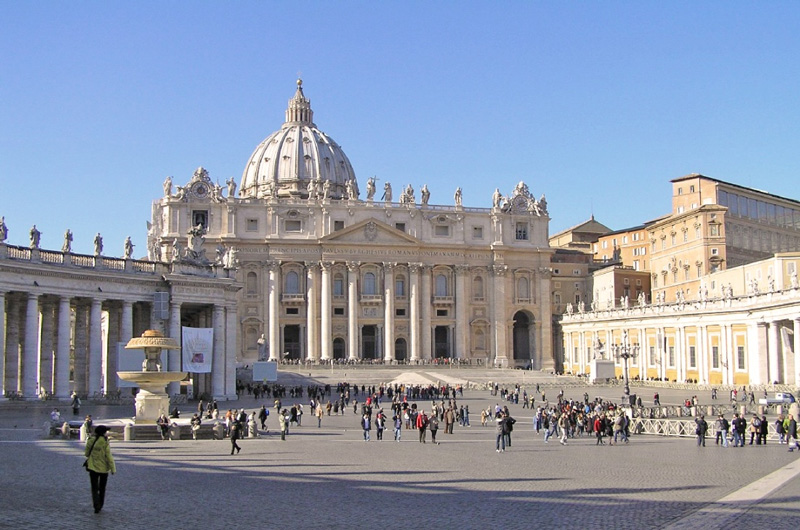
Days 12 & 13 – AMALFI COAST
Welcome to the Amalfi Coast!
Costiera Amalfitana is Italy's most scenic stretch of coastline, a landscape of pastel-coloured villages terraced into hillsides, steep panoramic roads, luxuriant gardens and enchanting vistas over turquoise waters and green mountains.
Considered by UNESCO "an outstanding example of a Mediterranean landscape, with exceptional cultural and natural scenic values," the coast has been a World Heritage Site since 1997. You may go from town to town at the discovery of Amalfi, Positano, and Ravello, three of the most beautiful villages in Southern Italy, world-famous for their charm and colourful architecture.
Amalfi typically has Mediterranean architecture with lanes and characteristic white houses piled one upon the other. In the Middle Ages, it was one of Italy's four powerful maritime republics (with Venice, Pisa, and Genoa). All sea trade in the Mediterranean was once governed by the 12th century “Tavole Amalfitane”, one of the world's oldest maritime codes. A must-see in Amalfi is the Duomo di Sant'Andrea, fronted by an intricately patterned façade, redone in the 19th century. Founded in the 9th century, the Cathedral's subsequent alterations have spared its principal glory, the main portal's 11th-century Byzantine bronze doors. Next to the church lies the Chiostro del Paradiso (1268), or Cloister of Paradise, whose serious Romanesque tone is animated by the Arab elements in its sinuous columns. To escape the bustle of Amalfi, let’s take the famous walk along the “Valle dei Mulini”, a steep-sided valley dotted with ruined watermills – “i mulini” - once used to make paper, an industry for which Amalfi was, and still is, famous.
Positano sits in a splendid panoramic position on one of the most beautiful stretches of coastline. Its enchanting town centre of delightful pastel-coloured houses surrounds the parish church of Santa Maria Assunta; its streets are lined with quaint, colourful shops, and its numerous beaches are world-famous.
Ravello is more elevated than the other pearls of the Amalfi Coast, boasting exceptional views of the coast and its marvellous villas and gardens. French novelist André Gide said they are “closer to the sky than the sea”. Here you may visit Villa Rufolo, built in the 13th century, which hosted popes and kings, and Richard Wagner, who composed part of his opera Parsifal here in 1880. Views from its idyllic gardens are magnificent!
A trip to Cetara is an absolute must. The village is renowned for a particular gourmet speciality, “colatura di acciughe” (anchovy sauce), produced according to an ancient procedure for generations. Spaghetti with colatura di alici is the area's typical recipe, a dish you will remember forever. Discover the secrets of the liquid gold of the Coast in the article in our BLOG.
At dinner, don’t miss Spaghetti with clams in olive oil and garlic sauce, or Seafood Risotto, with a glass of excellent Greco di Tufo white wine.
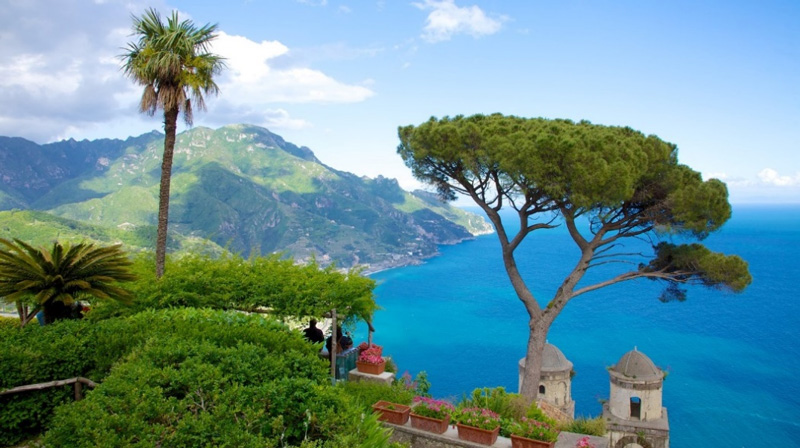
Day 13 – CAPRI
With a steep, jagged coast and encircled by the famous “Faraglioni” (sea stacks), enormous and uniquely shaped boulders, and by numerous caves that tell of evocative plays of light, Capri offers a landscape of wild beauty sculpted by wind, sea and the hand of man. The most famous of these caves is the “Grotta Azzurra” (Blue Grotto), closely connected to the history of tourism in Capri.
Its discovery by the ancient Romans is hinted at by countless archaeological finds - e.g. Villa Jovis, whose construction was commissioned by Emperor Tiberius.
The island continues to be both a legend and a favourite destination for travellers, intellectuals and the international jet-set - "performing" at any given time in the legendary “Piazzetta”, the real-time theatre of the island's 'Dolce Vita'. Beyond sea and nature in all their charm, Capri offers many chances for excellent shopping: elegant boutiques and artisans' studios selling “Made in Italy” items and typical products alternate along the characteristic sidestreets and alleyways. Moreover, the flavoured local food is tied to the island's maritime and peasant traditions.
The island is associated with the myth of the Sirens due to the presence of the homonymous rock of the Sirens characterizing the bay of Marina Piccola. Servius's commentary on the 5th song of Virgil's Aeneid is among the sources that feed the legend. The poet narrates half-bird and half-woman creatures that would have lived in Capreae and who, with their songs, bewitched the sailors and sent them against the rocks. On the other hand, the physical conformation of the island, made of coves, caves and precipices, makes it perfect as a refuge for these mythological beings.

Day 14 - POMPEI
Pompeii, the Roman city excavated from the ashes of Vesuvius, has been a UNESCO World Heritage Site since 1997!
In 62 AD, the city was partially destroyed by an earthquake. As its reconstruction was still ongoing, on August 24, 79 AD, the eruption of Vesuvius covered the city and its suburban villas with a thick layer of stones, ashes and lapilli (thick, glassy lava). On the other hand, Herculaneum disappeared beneath a flood of volcanic mud.
The ruins of the ancient Roman cities offer an unparalleled window into the quotidian life of classical antiquity. Here you can understand how the Romans of the 1st century AD lived: from brothels and lavatories to posh dining rooms and bathing establishments, including modern spas, health clubs and gyms. The eruption of Mount Vesuvius destroyed the town in 79 AD, and the debris ejected by the volcano covered more than 3,000 people from the volcano.
Due to its healthy climate and pleasant scenery, Pompeii was a holiday resort for wealthy Romans. It is now famous for its civic buildings lining the streets, which are still intact today. The Surgeon’s House, the House of the Faun and the House of Chaste Lovers are exceptional examples of the epoch’s architecture. Another unique building is the House of Mysteries, deriving its name from the murals depicting the Dionysian cult's initiation rites (i.e., the mysteries).
A peculiar characteristic of Pompeii is the florid graffiti covering the walls in just about every building; when the volcanic eruption happened, Pompeii was set to carry out elections in the days ahead – hence the writings and ideograms, which feature both political and sexual content.
The tour is over, but the memories of a fantastic journey will accompany you for a lifetime!
Arrivederci for another tour with VITOR, Visit Italy on the Road.
